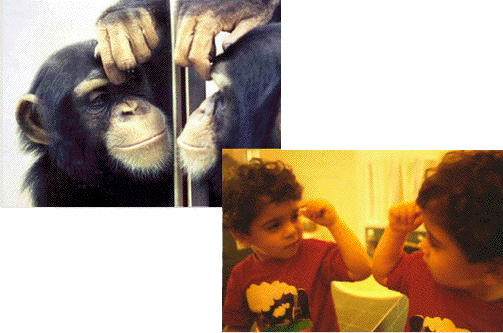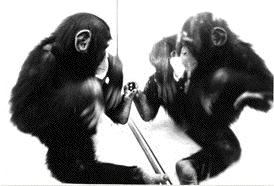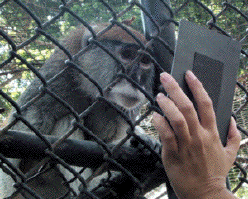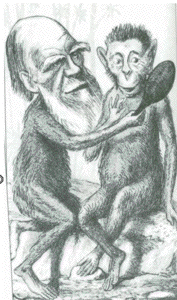- Mirrors have been used in field studios of
birds to elicit various behaviour-patterns, and
it has also long been known that anthropoid apes
take, a great interest in the perception of
their mirror-images. Thus Yerkes and Yerkes
described how "in any captive chimpanzee, but
especially in an isolated and, therefore,
lonesome individual, the self-image, commands
attention and arouses interest which loads to
varied investigative expressions. In a word, the
novel object is treated as if it were a fellow
being. It may be touched repeatedly with
fingers, hands, feet, lips, checks, or poked,
slapped and struck gently or vigorously with
hands, feet or both. Also there may be sudden
reaches behind the mirror, if such is used as
source of image, in seeming endeavour to
surprise the other animal and grasp it. Social
interest for a times waxes, as such behaviour
runs its course; then it wanes, and presently
the image is neglected".
-
- Systematic observational or experimental
studios of the behaviour of captive monkeys and
apes towards their mirror-images or reflexions
or to other mirrored objects or animals are,
however, lacking. The present investigation
arose as a result of preliminary observations of
so-called 'imitation' and 'social facilitation'
in four patas monkeys, Erythrocebus patas. Those
monkeys had all been recently captured in
Northern Nigeria, and wore obtained through the
Wellcome Research Laboratories at Bockenham.
Until they came to our own laboratories, they
had not taken part in any kind of experimental
situation. It is reasonable to assume that, in
the wild, these animals would net see anything
comparable to the mirror-image other than the
reflexion of themselves on the horizontal plane
such as is provided by stream or pond water.
Hence, the initial, and subsequent, behaviour of
such experimentally unsophisticated animals to
mirrors or mirror-like situations seemed to be
worthy of investigation.
 -
- Of the four monkeys used in the work, two
were full-grown adults, one male and one female,
and two wore juveniles, also, one male and one
famale. The exact age of none of them was
ascertainable. They wore normally kept in
separate, living cages, and, according to the
exporimental situation, were net allowed to see
or have contact with each other. The two young
ones were kept in one room, and wore let out on
most days to be together in a large cage which
was divisible into two compartments according to
the requirements of the social facilititation
and imitation studios. The two adults were in a
separate room adjacent to this, and they were
also occasionally allowed out into the room.
During the latter part of the observations, all
four cages were, put in the same room while
alterations to the other rooms wore being made,
but appropriate screening of the cages was
carried out when experimentally necessary.
-
- Prior to any experimental observations being
made, it was noted that whenever the two young
monkeys were released into their living room,
they showed intense and active interest in the
images of themselves that they could see in the
glass parts of the partitions dividing, on two
walls, their room from the adjacent two rooms.
The behaviour seen consisted of a variety of
observing responses, such as standing on
hindlegs, crouching low to the ground with head
held low and staring, and of cautious approach
towards the partition. In addition, the young
female, in particular, frequently made
'gaping' or 'yawning' responses in which,
while staring towards the reflexion, she lowered
the head while opening the mouth to fullest
extent, then raised the head again to the normal
horizontal position. This reaction would occur
with the animal in the sitting, normal standing,
or low-crouched postures, and in partial form
(for example, opening wide of the mouth without
lowering of the head) as well as in the complets
form described. The significance of this
reaction, its variation in form and in
circumtances of occurrence, and its relations to
other behaviour components of the
species'repertoire have yet to be fully worked
out, so that the term 'yawning', to be
used hereafter, is simply a usefully descriptive
one. A similar reaction bas been described in
wild chacma baboon males by Hall, and in captive
rhesus monkeys by Rinde and Rowell. The interest
to the two young animals of those reflexions in
the glass partitions delayed any kind of social
responses between the two often for several
minutes after release from the cages.
-
- The adult male's responses in the same kind
of situation were even more prominent, the
'yawning' being often a reaction in which
the head was lowered, when the animal was
standing, almost to the ground. The adult
female, on the contrary, tended to show cautious
investigatory and observing responses and
rarely, if ever, 'yawned'. This female
had been a cage-mate, of the adult male for some
wooks prior to coming to our laboratories. The
adult male has shown a similar, but much
briefer, kind of response on seeing his image in
a pane of frosted glass standing upright against
a wall.
-
- Further indications of the value of this
technique came from observing the behaviour of
these animals when given access to a small
hand-mirror in the cage or lying on the floor of
the room. Here the monkey is able to move the
mirror about, and the fascination of it to them
was strikingly apparent. Indeed, its interest
for the young ones in particular was such as
frequently to counteract the attraction of
preferred food items, such as fruit, in the
vicinity of the mirror. Further, the two young
animals tended to show as much interest in it
when they wore together as when they were
viewing it individually in their cages. In fact,
the interest of one in it tended to be
accentuated the investigatory and playful
behaviour towards it of the other, so that
social facilitation seemed here, as on many
other occasions, to be operating strongly.
-
- The typical behaviour of the two young when
given the small hand-mirror separately in their
cages, has consisted of a wide variety of
investigatory behaviour, such as peering close
up to it, licking at its surface, chewing the
edge of it, pawing at its surface, picking it up
and holding it in one hand or both hands,
usually close up to the face, and sometimes
putting one hand round to the back of the mirror
as though trying to touch the reflected object.
Both those animals have also frequently looked
obliquely into the mirror, either when holding
it up, or when it is lying flat on the ground,
and on one occasion the young female
'yawned' while thus looking, and then
immediately turned and 'yawned' at the
observer whom she had apparently viewed in the
mirror.
-
- In a series of trials carried out over
sevaral days, and using a variety of different
surfaces of the same sized object ranging from
completely black to full reflecting, the
presentations being randomized to central for
serial effects, there is clear evidence of
differential stimulating effects according to
the degree of mirror-image discernible. It is
also clear, however, that there is a gradual
habituation ta the mirrorimage as is shown by
the fact that both young animals reduced their
investigatory time with the full-reflecting
hand-mirror front 100 par cent for each on the
first 5-min trial to 60 and 63 par cent
respectively on the fifth 5-min trial. There
are, however, oscillations with some, of the
intermediate mirror-surfaces which. suggest that
the incomplete images may possibly be less
subject to habituation than the complete, but
these trends need further systematic
investigation.
-
- When the hand-mirror has boon placed on the
floor of the room in which the two young animals
have been freed from their cages, it still
remains very compelling to them. Thus, the young
female immediately on leaving her cage has come
straight up to the mirror, peered into it as it
lay on the floor, picked it up and held it close
to her face, and carried it about with her, even
though she was free to climb on the window
ledges and look out or explore the rest of the
surroundings. The young male also frequently
attended closely to the mirror and manipulated
it, and often has followed the reactions of the
female to it. On one occasion he grabbed the
mirror in his hands as she hold it to her face
and tried to pull it away from her. She then ran
away from him on her hindlegs clutching the
mirror in both hands. This young female has
always had priority of access to preferred food
items, snob as fruit, when the two young ones
have been together. However, when the rnirror
has also been available to her, she has tended
te leave only partly eaten such objects as
bananas, and has even tolerated the young male
eating a part of a banana very close to her
while she has been gazing at her
mirror-image.
-
- The reactions of the adult animals, when the
handmirror has first been placed in their
individual cages, have been markedly different
from those of the young ones. Thus, when it was
placed flat in the food bowl in the adult male's
cage, he reacted immediately with startle, and
jumped away to the back of the cage. The
reaction was evidently in response to the
mirrorimage of himself because it occurred as
soon as ho stood looking down from directly
above it. He then avoided the mirror and went to
sit at the back of his cage. Whenever he did
glance towards it, his behaviour showed
uneasiness in frequent 'yawning' and
movements of the lips. It was only after 12 min
from the time whon the mirror had been put in
his cage that he again come and stood looking
down on it, and again at once jumped away from
it, 'yawned' six times in rather rapid
succession, stood on his hindlegs above the
mirror, and then gave a sories of thirteen
'yawns' at a rate of about one every 15
sec. He continued with this kind of behaviour
throughout the whole period of the trial and
also climbed around inside his cage very
actively. Only after 15 min did ho for the first
time put one hand out and touch the mirror very
gingerly. During the next 6 min he picked up
food pellets in his mouth, but without chewing
and eating them, merely nibbling at their ends,
and he also picked up nutshells that were lying
near the mirror.
 - The adult female's reactions ta the
hand-mirror likewise showed startle, on first
perceiving the mirrorimage, but then a cautious
but more or less continuous investigatory
behaviour shown chiefly through peering at the
mirror, looking underneath it, twice putting her
face right up against its surface, looking
briefly into it, but never actually touching it
with her hands. For the 5-min period following
removal of the mirror from her cage, she
continually searched around inside, the cage
peering several times under the wooden board on
the cage floor, looking under the food bowl in
which the mirror had been lying, and so on.
Thus, in a preliminary way, these observations
on those four animals suggested the potential
value of a more controlled study with systematic
variations of the mirror-stimulus
condition.
-
- Tho first of these studios is described now
in outline. A two-sided mirror, 30 in. high by
18 in. wide, was mounted vertically on a wooden
faur-wheeled carrier, enabling it ta bc moved
readily from. one part of the laboratory ta
another. This mirror, sufficiently large for the
animal to perceive the whole of its standing
frontal image, was used on experimental trials
at varying distances and conditions, while
control trials were systematically interspersed
with the experimental ones as a check on the
effeetiveness of the mirror as such rather than
of any other conditions surrounding the animals
and affecting their behaviour. The control
observations were made either when the mirror
was set directly in front of the animal in
exactly the same, way as for an experimental.
trial except that the mirror-surface was kept
covered with a white cloth, or when the mirror
was exposed ta the direct view of the animal in
the next cage but only to the indirect view of
the central animal, or when the animal was
screened from seeing anything but the usual
laboratory environment. Common to all trials,
experimental and central, were the presence of
the same two observers, and the operation of
recording equipment.
-
- The behaviour of the two adult animals, whon
confronted with the mirror separatoly and at
distances of 3, 6 or 9 ft. from the front of the
cage, indicated a high degree of tension in
comparison with their behaviour in the central
situations. Typically, the adult male stood with
body tensed, or sat with his back straight and
his head alert, staring into the mirror and
'yawning' repeatedly with the mouth
gaping open wide and the head going low towards
the ground. The head then tended to jerk back to
the normal gazing position. On the first mirror
trial with the male, this reaction occurred
fiftean times during the first 60 sec, that is,
once overy 4 sec. On this and subsequent trials
on other days, the 'yawning' frequency
decreased rapidly ta near zero a minute over the
trial period of 10 min. However, as this
response waned it gave way to other, and perhaps
lower intensity, behaviour patterns, also
indicative of tension. Thus, the male began
repeatedly to pick up in his fingers the
standard food pellets lying in a bowl in his
cage and rubbed them repeatedly and for several
seconds with a rolling motion between his two
hands before nibbling the end of the pellet,
without actually chewing any of it off, then
finally letting the pellet drop to the floor and
picking up another.
-
- From observation of his normal undisturbed
feeding behaviour with these pellets, it is
clear that the rubbing is far in excess of that
which he usually adopts with this food object,
and it is also obvious that the nibbling and
discarding of the pellets in this way is an
unusual procedure for this animal. When engaging
in this kind of 'false' feeding behaviour, the
male sat sideways on to the front of the cage,
so that he avoided seoing the mirror-image. In
normal feeding, he tends to face towards the
front of the cage.
-
- A.nother indication of tension in the adult
male's behaviour to the mirror seemed to be an
increased frequency of self-scratching, as
opposed to selfgrooming occurrences.
Self-groorning is a leisuroly pickin-over of fur
and skin, while self-scratching has here been a
brief episode of rapid, dog-like scratching; for
example, of the back of the neck by the hind
foot. To what extent the mirror situation has
affected the sexual behaviour of this animal is
net yet clear; but it is possible that the
observed occasions of erection of the penis and
of masturbation during the experimental trials
wore brought on by the conflict nature of the
situation.
-
- As a variation, the vertical mirror was once
placed et a distance of 9 ft. from the front of
the adult malo's cage, uncovered, and then moved
slowly by the experimenter towards the cage.
This elicited a dramatic and highly intense
series of reactions. During the first minute, as
the mirror was approaching him, he stood close
to the front of the cage and 'yawned' 23
times, that is, at a frequency of 1 in about 2.5
sec. Thereafter, the 'yawn' frequency
decreased sharply, giving a total for the 10-min
trial of 67. When the rairror was right against
the front of the cage, the cage door was slid
aside se that there was no barrier between the
male and the image. The effact of this was
instantaneous, the animal et once striking
repeatedly at the mirror with both hands, trying
to bite at its surface, and pressing hard
against it. This hand-scrabbling and pressing of
the face towards the mirror, interspersed with
occasional 'yawns', continued throughout
the trial, except for brief intervals during
which he scratched and sometimes picked up food
pellets from the bowl but threw them immediately
aside. When the mirror was moved away at the end
of the trial, he continued to move restlessly
about his cage, climbing around it, as though
attempting to get out, and standing on hindlegs
looking around the room. This approach trial
was, as would be expected, much more effective
in arousing intense and varied behaviour than
the trials where the mirror was static.
-
- The adult female, when shown the rnirror at
a fixed distance in front of her cage,
'yawned' 14 times only in the first
trial. This can be compared with the first trial
frequency of 50 for the adult male.
'Yawning' was thus net the most prominent
response of this animal to the mirror. Rather
was her behaviour on the experimental trials
characterized by cautions investigation, as
shown by her low crouching postures, peering
towards the mirror, looking continually around
her cage, around the room, up te the ceiling and
towards the cage of the adult male. Her
agitation or uncertainty was, however, indicated
by an enormous incresse, in frequency of
self-scratching episodes during the
experimental, so compared with the control,
trials. On one trial, frequency of this response
built up to a peak as her 'yawning'
frequency waned, and 43 separate scratching
opisodes were observed in the 10-mon trial, as
compared with an average of 8 or less in control
conditions.
-
- This female's behaviour was markedly
oriented much of the time towards the adult male
on those experimental trials whore the screen
between them was removed, enabling them to see
each other. She repeatedly looked toward him,
and he showed a high degree of alertness,
standing repeatedly on hindlegs, gazing out in
the direction in which she was looking, and
occasionally 'yawning'. It seemed thus
that he was responding, not to the 'common
stimulus' provided by the mirror-image, for that
was not visible to him, but to the agitated and
watchful behaviour of his female partner. The
mirror technique, used in this way on a pair of
animals, seems to offer one simple way of
studying in the laboratory what Miller, Murphy
and Mirsky have called 'communication of
affect'.
-
- The two young anirnals, have only so far
been given the vertical mirror when they are
free together in their large living cage. The
immediate affect of the mirror being placed in
this cage was to inhibit their vigorous
play-activity, including sexuel play such as
mounting, biting, etc., and to concentrate the
attention of both animals on the mirror itself.
Therefore, far from being an attraction only for
an isolated animal, as Yerkes and Yerkes have
suggested, it has seemed to have an effect
perhaps comparable with the first introduction a
new monkey of about the same age as the two
others. The young female, in particular,
scarcely ever left the vicinity of the mirror
while it was in the large cage, and, when she
had peered into it, she scraped at its surface
with her hands, and put her face right against
it. She then continually walked round and round
the mirror rather slowly and cautiously, looking
at it from all angles. The young male, although
also interested in the mirror, as indicated by
his gazing full into it and waving his arms
towards his own image, tended rather, as in
other performances when the two have been
together, to follow the female around, and hence
to do more or less what she was doing.
-
- The frequency data on the distinctive
behaviour patterns, such as 'yawning',
scratching, fumbling with food pellets, etc.,
may all, it seems, be used in full-scale
experiments to indicate significant trends in
the reactivity of the animals to the many
variations made possible by the mirror
technique. The study of habituation is itself,
in the primates, a neglected aspect of learning.
Our own preliminary data, using 'yawning'
as the response selected for special attention
because of its prominence, show a progressive
waning in frequency over successive days, as
well as within 10-min trials as from the first
to the last minute. When more than one
experimental trial has been carried out on the
same day, the habituation effect has been even
greater, and it is probable that it would turn
out to be proportional to the time interval
elapsing between the end of one trial and the
start of the next. Two further points are
suggested by the results. First, if an interval
of 24 h occurs between the end of one
experimental trial and the beginning of the
next, there is a fairly marked initial increase
in the frequency of the 'yawning'
response. Secondly, as habituation of the te his
mirror image progressed, se his more or less
complets lack of response to the control
situation of covered mirror or mirror te the
side of his direct nview has tended to alter.
Thus, on the fist control session, no
'yawns' were recorded, while 50 were
recorded in the first experimental, session. On
the fifth dy from the beginnig of experiments,
the mirror elecited only 5 'yawns' four
of them being in the first minute of the trial,
and the control situation elecited 13
'yawns', but these were rather evenly
spaced throughout the course of the trial. It
would thus seem that, with the habituation to
the mirror-image there is a conditioning of
agonistic responses to the mirror-when-covered
or to the situation in general, which therefore
come to elicit a rather greater general level of
tension than the normal These statistical trends
are illustrated in Fig. 1 but it is clear that a
complex of social and motivational factors must
be operating in these animals which may affect
all aspects of their behaviour towards the
mirror-image. Thus, it is perfectly possible
that the œstrous condition of the female
may affect her behaviour towards it, as also may
her proximity or otherwise to the adult male
with whom she is on intimate relationships.
Similarly, the reactions of the adult male to an
apparent image to another adult male might be
expected to vary considerably according to the
social context.
-
- Those preliminary observations suggest that
the mirror technique, with its potentialities
for experimental variation and for standardized
presentation of 'social'stimuli, may be usefully
developed to sample the behaviour of such
animals in the restricted setting of laboratory
space. Some of the learning processes involved
in social approach and avoidance behaviour,
highly complex in the natural group situation,
can, it seems, with the aid of this technique,
be selected for systematic experimental
investigations which may help to bridge the gap
between field and laboratory findings on
non-human primate behaviour. At least in this
way realistic situations can apparently be given
to the animal so that they elicit a variety of
conflict, frustration, and investigatory
behaviour patterns, in circumstances where they
can be objectively and quantitatively
recorded.
-
- Pandiculation:
the comparative phenomenon of systematic
stretching AF Fraser
|






